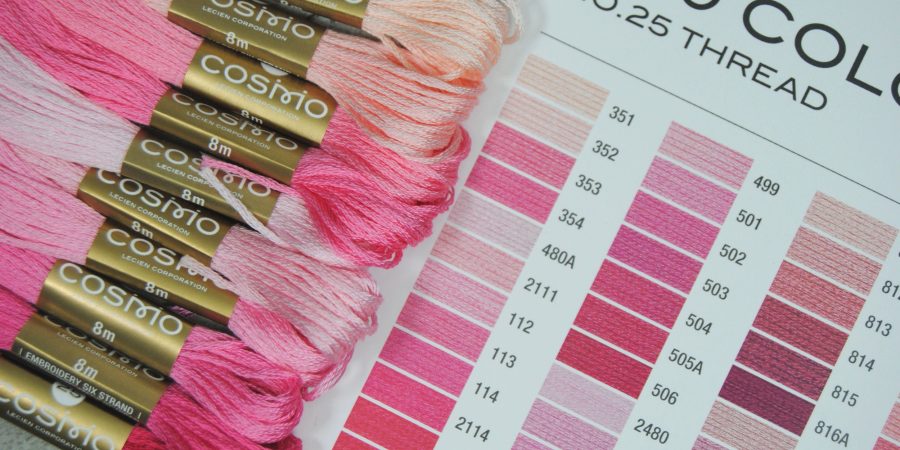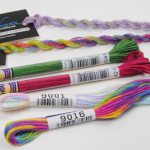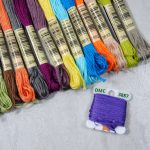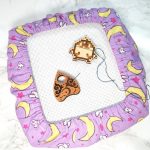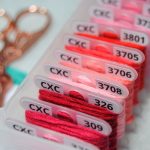I’ve been working with Cosmo threads for a few years now, but only the ‘Seasons’ line of variegated threads. They’re absolutely gorgeous but it’s harder to work them into designs regularly. So I recently started working with the main line of Cosmo threads and found a lack of resources online to get started. Naturally, I ended up making my own! I’m here to share those with you to make your transition easier.
As per usual, use the Table of Contents to skip ahead to the parts you’re most interested in.
This post may contain affiliate links. If you buy something using one of these links, I earn a small commission. However, there is no extra cost to you. Thanks for understanding! Learn more in my Disclosures & Privacy Policy.
Table of Contents
Why work with Lecien Cosmo Threads
First of all: WHY work with Lecien Cosmo threads?
You’ve got a ton of DMC already, isn’t that good enough? Absolutely. Sure.
But there are colors that are available in Cosmo threads that just don’t have a good equivalent in DMC. If you’ve ever been frustrated at the lack of warm tone purples in DMC or struggled to figure out a good cohesive set of grays… maybe try another brand!
Cosmo also is very pleasant to work with and it’s just fun to try out new materials and expand your horizons.
Can You Mix Cosmo threads and DMC threads?
Possibly a controversial opinion, but YES. You can absolutely use both Cosmo and DMC in a single project if you want. There is no stitchy police. If you just want a few Cosmo colors to fill in the ones that simply don’t exist in DMC, great! If you just want those super colorful variegated threads to mix into your projects that’s fine too. There are no rules in artistic expression. Get creative!
I’m just here to give you some resources to help you if you want to try out a new brand. So let’s get to it!
Where to Buy Cosmo Threads
While pretty well known in Japan, Cosmo is still relatively unknown in other markets. So one question I get a lot is… where do you even buy it? A lot more places than when I did my initial review back in 2020! So let’s talk about the online shops I found:
US Based
(In no particular order other than the order I found them in)
- 123Stitch – Texas
- SnugglyMonkey – North Carolina
- FatQuarterShop – Texas
- RedRockThreads – Nevada
- ThreadBearFabrics – Georgia
- CrabAppleHill – Washington
- BeansandStitches – Colorado
- RiverviewStitching – Michigan
- OhSewRetro – Georgia
- RittenhouseNeedlepoint – Pennsylvania
- StarlightStitchery – Oregon
- ShabbyFabrics – Idaho
- Northwest Yarns – Washington
- Bee Youtiful Sip and Stitchery – Illinois
Or try using NeedleTravel to find some local-to-you needlework stores that you may not be aware of!
International
I’m US based so I’m not familiar with all of these, but here’s some I found online or where recommended to me from international stitchers. Yes I do know a lot of Australian stitchers apparently. I wasn’t able to find a ton for Europe though. 🙁
This is absolutely not a comprehensive list, so if you know of any, please let me know!
- AllThreads – Australia
- FabricPixie – Australia
- GumValleyPatchwork – Australia
- CraftyFrog – Australia
- Quilter’s Angel – Australia
- The Workroom – Canada
- EweKnit – Canada
- CasaCecina – Italy
- RobertaDeMarchi – Italy
- The Eternal Maker – UK
- PoppyPatch – UK (Seasons Only)
Tracking inventory
One of the first things I like to do with any new brand is put together a list of all the colors available. This both helps me pick out which colors I want to invest in to start, and builds good habits to keep me from accidentally doubling up on colors in the future.
Most of that is cross referencing many different sites to ensure all colors (even discontinued ones) are represented on the list. This can take quite a bit of time but is well worth it in the end.
Cosmo Threads Inventory Spreadsheet
But you don’t have to go through all that, as I’ve helpfully put together an inventory spreadsheet for you to get started! Make sure to click File –> Make a Copy to get it into your own Google account, allowing you to start tracking how many skeins of each color you own.

This will also allow you to use the headers at the top to sort by color (Click and select ‘Sort A to Z’), by number, whether or not it’s discontinued, etc.
You’ll notice there’s several tabs though, so let’s discuss the types of thread included.
Cotton Size 25

The bulk of the list is going to be the Cotton Size 25 line. In other words, the standard 6-stranded cotton commonly used for cross stitch and embroidery. At the time of writing, they offer 501 unique colors.
Why 501? Why not an even 500? That last one is actually a multicolored thread. 258 is a variegated thread that is for some reason included in the main Cotton line rather than the Cosmo Seasons we’ll discuss later. It’s made up of 1 meter sections of 8 different colors from the main cotton line.

Discontinued Cosmo Threads
I also found about 37 discontinued colors . Though most of them are technically updated colors. Cosmo threads seem to pride themselves in having smooth color ramps for more satisfying gradients. As such they occasionally update a color to better fit in with the others in the same range. This is where the ‘A’ colors come in, as they have been Adjusted. For example 577 has been discontinued, but it is still available as the slightly different shade 577A.
However, I could not find proof of non-A versions of all the colors, so there may be more discontinued colors. I only included the non-A versions where I could find any proof of their existence.
Size 5 Cotton Pearl
Lecien does also offer a Size 5, or Cotton Pearl line. So if you’re an embroiderer who prefers Pearl Cotton you may want to look into that as well.
It’s not as commonly used in Cross Stitch so I’ve left that out for now. Mainly because I kept finding conflicting information as to which colors were available in size 5. It doesn’t come in ALL the colors, but I haven’t been able to confirm which colors it is available in just yet. I’ll update this spreadsheet if I can get an official list from Lecien themselves.
Cosmo Seasons – Variegated Thread
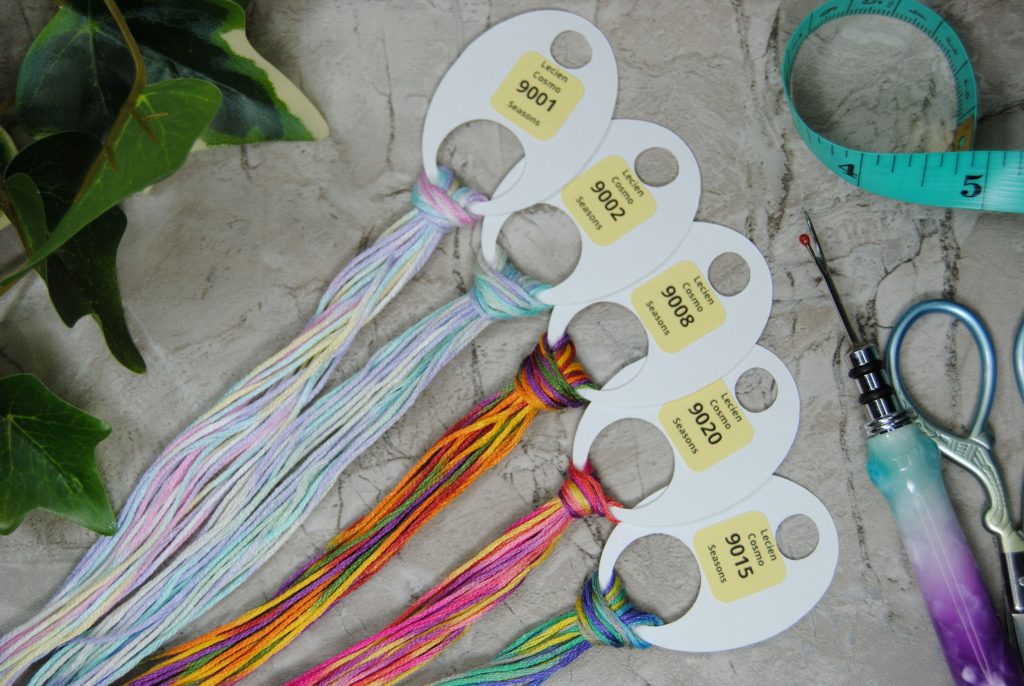
Now for my favorite line — Cosmo Seasons! Aka the fun variegated threads. If you’ve never worked with multicolored thread, check out my tips for cross stitching with variegated threads article, as it covers what brands offer them, what patterns work well with them, and how to stitch with them to make sure it looks good.
The Cosmo Seasons line are divided into groups depending on how often the thread changes color. They have a lovely illustration of this on their website. But basically it boils down to the following:
- The 5000 colors have colors evenly changing every 3.14″ or 8cm.
- The 8000 series are a more subtle gradient
- The 9000 series changes are a more ‘random’, having both long and short bits of each color.
This is important when deciding how you want to stitch with them, whether you’re substituting a color for a subtle variegated version of that color, or letting it be a bit more varied to draw the eye in a normally single-color pattern. But I go into that more in that variegated threads article I mentioned above.
Nishikiito – Metallic Cosmo Threads
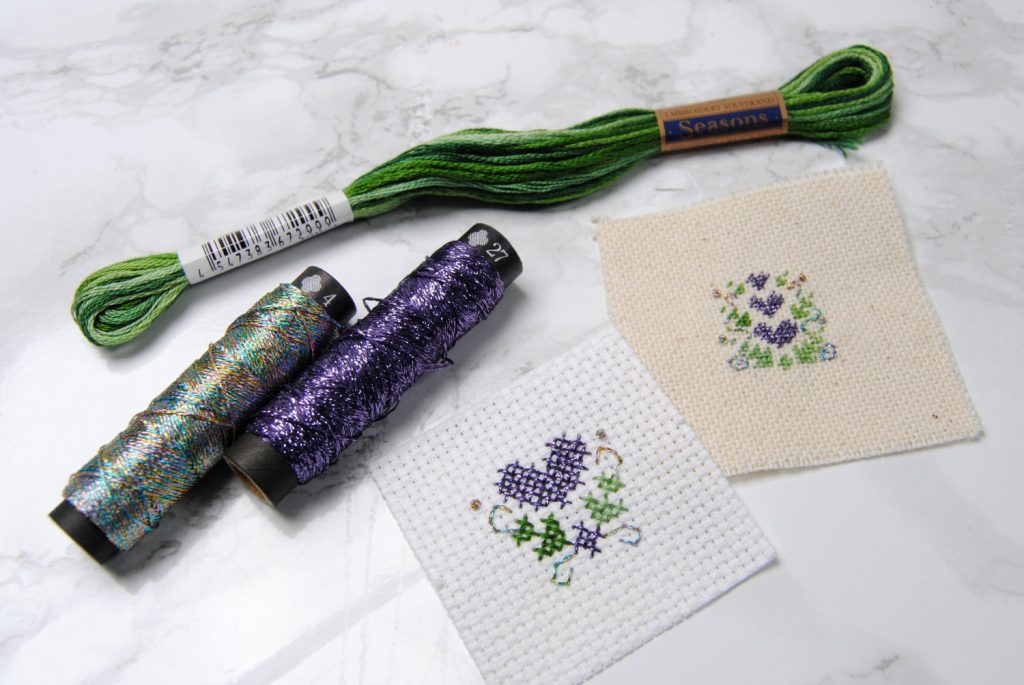
Lecien’s metallic threads are called Nishikiito and come on a spool rather than a skein. These are broken up into multiple categories as well, which I’ve labeled on the inventory spreadsheet to make it clearer.
- Nishiki – Subtle metallic colors used in traditional Japanese clothing.
- Kagami – The much brighter counterpart to Nishiki, with added shine/ glitter.
- Opali – A semi-transparent thread with more opalescent shimmer; formerly Shabon-Dama.
- Champagni – Pastel and gentle sparkles akin to champagne bubbles.
- Neoni – Bright, dramatic neon colors
You can find a full chart of their current Nishikiito colors here.
If you’re just curious what they’re like to stitch with, check out my Cosmo Nishikiito review from a few years ago.
Labeling Your Cosmo Threads
Ok shameless plug here. But with the free spreadsheets and design files I’m offering you here today I think it’s only fair to offer a paid product as well.
But… if you’re in the market for some bobbin labels or thread drop stickers to label your thread collection, and are getting into Cosmo threads… I have exactly that!

Plus as you work through the sticker sheets it doubles as a kind of checklist / shopping list of which colors you don’t quite have yet.
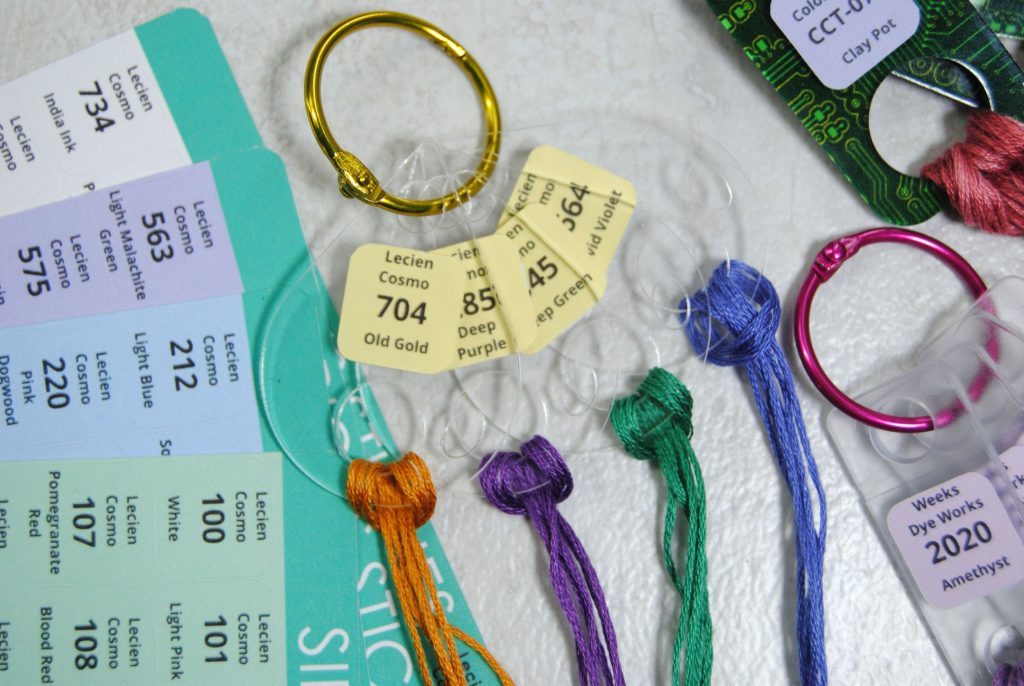
The thread drop labels were designed to fit on the small space of Annie’s Keepers drops, but look pretty good on a variety of drop styles.
Plus these stickers are available in a number of different brands, including DMC, Anchor, Weeks Dye Works, Classic Colorworks, etc.
Ok enough of the obligatory marketing, how about some more free resources for designing with Cosmo threads?
Designing With Cosmo Threads
If you’re an embroidery artist, just grab some colors and start playing around with them! It’s really the best way. Grab a color card to help you identify color ramps for thread painting and you should be good to go.
However, if you’re a cross stitch designer you’re probably going to have a program help lay everything out on a grid for you. Whether you start with a paper sketch or jump straight into designing in your program of choice, everyone tends to have their own favorites.
But most programs do not come with Lecien Cosmo threads by default! This can make it a bit more difficult to make color choices, especially if you don’t have all the threads in person to look at. Or a handy color card.
If you’ve ever gotten frustrated with a program not showing thread colors properly, that’s because it’s impossible to depict a 3D object such as thread in a single color value. Thread bounces light and the colors around it. It is textured. It is not a single color. So any color on your computer is never going to be 100% perfect. But we can estimate them, at least.
WinStitch / MacStitch Files
I went searching and found that a wonderful human being had already gone through all the hassle of determining RGB color codes for the main Cosmo threads cotton line! A human that apparently shares my surname but as far as I’m aware is in no way related to me. How serendipitous.
They have a great article discussing exactly how they went about picking these colors and normalizing their data. If you’re a nerd like me you’ll absolutely find it fascinating.
If instead you just want the .threads file, they included it on GitHub.
PCStitch Files
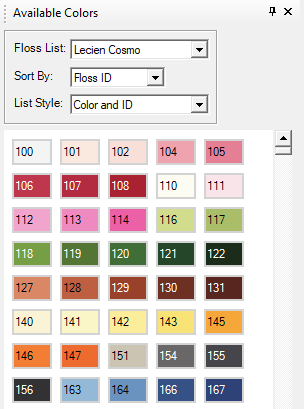
Alas, I do not use WinStitch or MacStitch. I use PCStitch. Is it perfect? Absolutely not. But I’m used to it. And sometimes that takes priority.
So I spent roughly 6 hours across a couple of days just entering in the color values into PCStitch’s Floss Editor, as well as mapping them to their DMC equivalents. Yep. All 500+ colors.
But hey, now you don’t have to! You can download the Lecien Cosmo PCStitch Files right here.
There’s a readme included for where to put the files depending on which version of PCStitch you have. I’ve tested it with both PCStitch10 and 11. You’re welcome.
Important: The number sorting sorts ‘A’ colors to the bottom of the list rather than inline with their other colors. If you prefer, you can edit the A off of those numbers so that they show up in their respective ramps instead. ‘A’ numbers basically just denote updated dye lots of old discontinued colors of the same number.
I included other discontinued colors, but they are labeled accordingly and start with D so they sink to the bottom of the list.
Also sorting by color does not work at all and I have no idea how to fix it. 🙁 Please let me know if you figure out what needs to be adjusted for this!
Other Programs
I’m not familiar with most other programs, but in that GitHub link I mentioned previously they included a csv (spreadsheet) with all the color values recommended. Both in RGB and in Hex.
This is what I used to create the PCStitch thrad list. If you use a different program, I’d recommend Googling a bit to find how to add custom colors to your program of choice. And then queuing up Netflix and getting to work manually entering them like I did.
Alternatively, make your design in DMC and convert the values! But that brings me to my next offering: a conversion sheet.
Converting Existing DMC Patterns
Alright, so you already have a design and have chosen DMC colors. Or you’ve bought a pattern that was designed with DMC in mind. Now you want to convert it to Cosmo. How do you go about that?
Color swapping tips
First you want to be very aware that not all DMC colors exist in Cosmo, and not all Cosmo colors exist in DMC. But you can get fairly close with most. You will however need to make some compromises along the way, and some decisions of your own. Some colors simply do not exist in one brand and you’ll need to pick something ‘close enough’. Sometimes there are two or more colors that are “close” to the color you want and you’ll need to pick based on your pattern.
For example, if you were converting a medium tone gray from DMC. There may be 2 medium tone grays in Cosmo, but one leans more warm tone and one leans more cool. Depending on what OTHER colors are in your pattern, you may want to go one way or the other.
The other thing that occasionally happens is that you might have chosen two close but different DMC colors in the same family. But for both of them the same Cosmo thread is the ‘closest match’. In which case you may need to choose the second closest match for one of them.
Plus, remember that your color vision might be slightly different than another’s. What you feel is the closest match might be different from what someone else would’ve picked. So don’t take my word for it. Compare to other conversion sheets or get yourself a color card. This is just a place to start!
Using a conversion chart
With all those disclaimers out of the way, I made a DMC to Cosmo conversion sheet based on my own judgement and observations!

I spent ANOTHER 10+ hours over a few weeks sitting in front of a my thread collection and comparing DMC to Cosmo thread colors. Some decisions were definitely easier than others.

Where possible I included at least 2 options, my first and second pick. Others I only included one option as none of the others in the range seemed close enough. With a few I simply did not feel comfortable recommending any substitute. You’ll want to just pick something in a similar range for those that fits in with the other colors in your pattern, under the understanding it won’t be a close match for the ‘original’ color.
You’ll also note in the ‘Credits’ tab I included links to 4 other conversion charts I found online. I did not go looking for those until AFTER I made mine so that I wouldn’t be influenced. However, reviewing them now they made different decisions than I would have. Just goes to show that it’s somewhat subjective what the ‘best’ color option is. Definitely cross reference and make your own decisions based on all the recommendations.
Either way, I hope that gives you a good head start at least. I am human though, so if you find any mistakes please leave a comment on the sheet!
Using a program to convert
Okay. I never recommend fully trusting a program to choose colors for you. Even in my PCStitch Basics article I discuss how I let PCStitch pick colors, but then manually go through and adjust them from there while going through my thread collection.
That said, if you’re using PCStitch you can tell it to at least try and convert them for you. First make sure you have your PCStitch floss list installed from earlier in this article.
Open your pattern PCStitch and go to Palette Tools – Convert Palette Entries and select Lecien Cosmo from the list.
As not all DMC threads have an equivalent Cosmo thread, you will get an error that some entries could not be converted. Check the box for “Use Calculated Maps for Missing Entries” to allow PCStitch to swap in its best guess for those threads. You can then manually replace any colors you don’t agree with.

If you use a different program such as MacStitch/WinStitch it may have a similar option, but I’m simply not familiar enough with those programs to tell you where. Ask around other designers or head to the Google and see what options exist!

